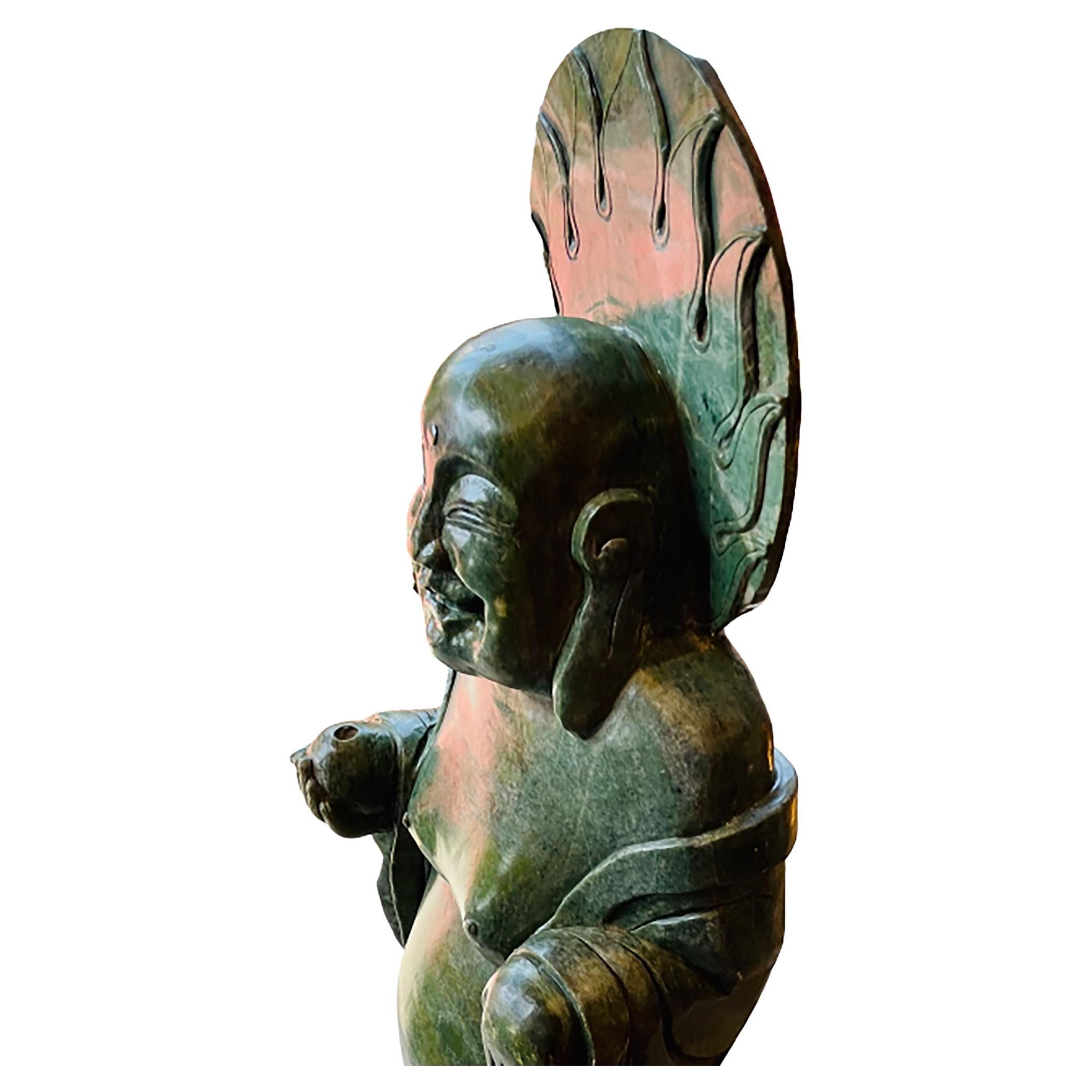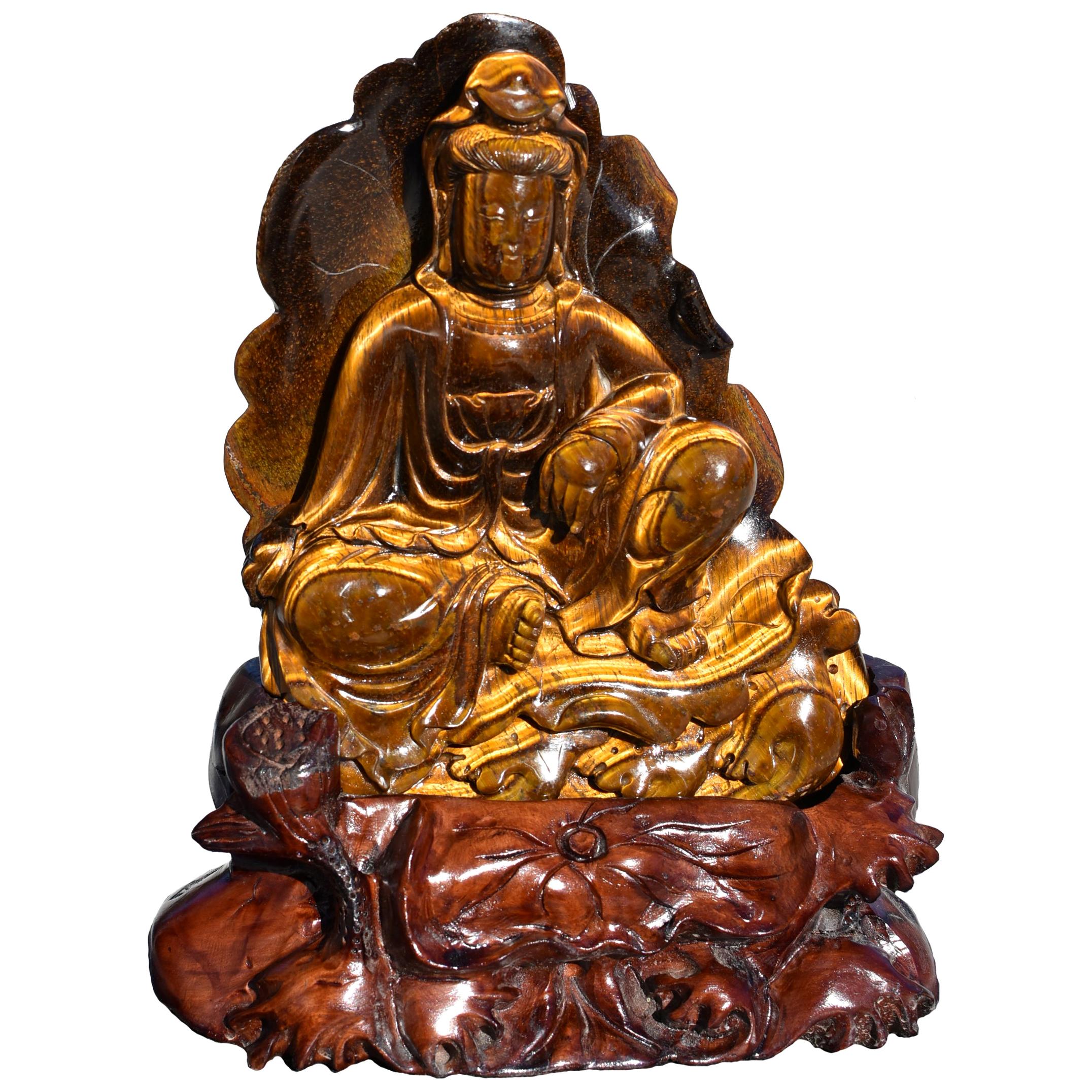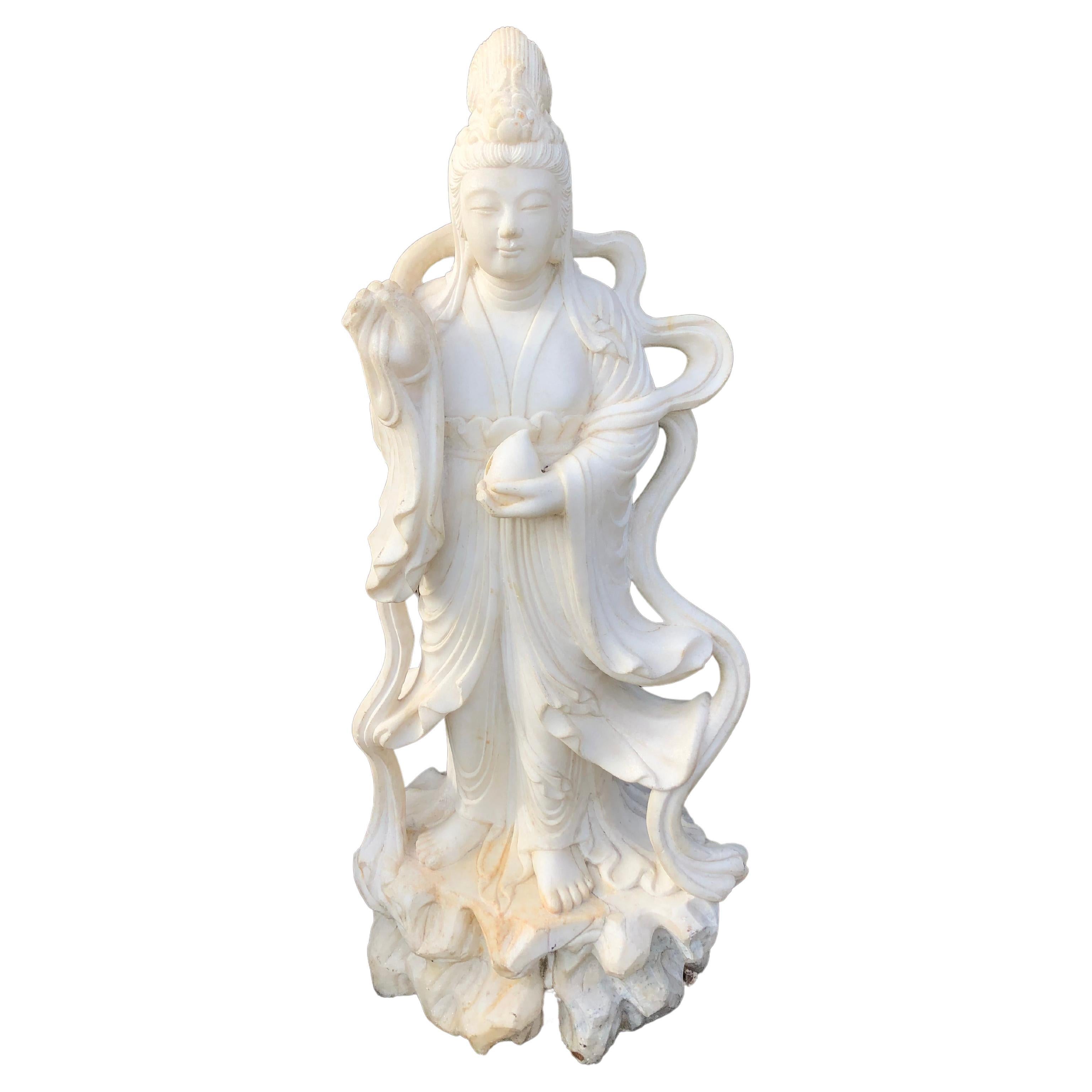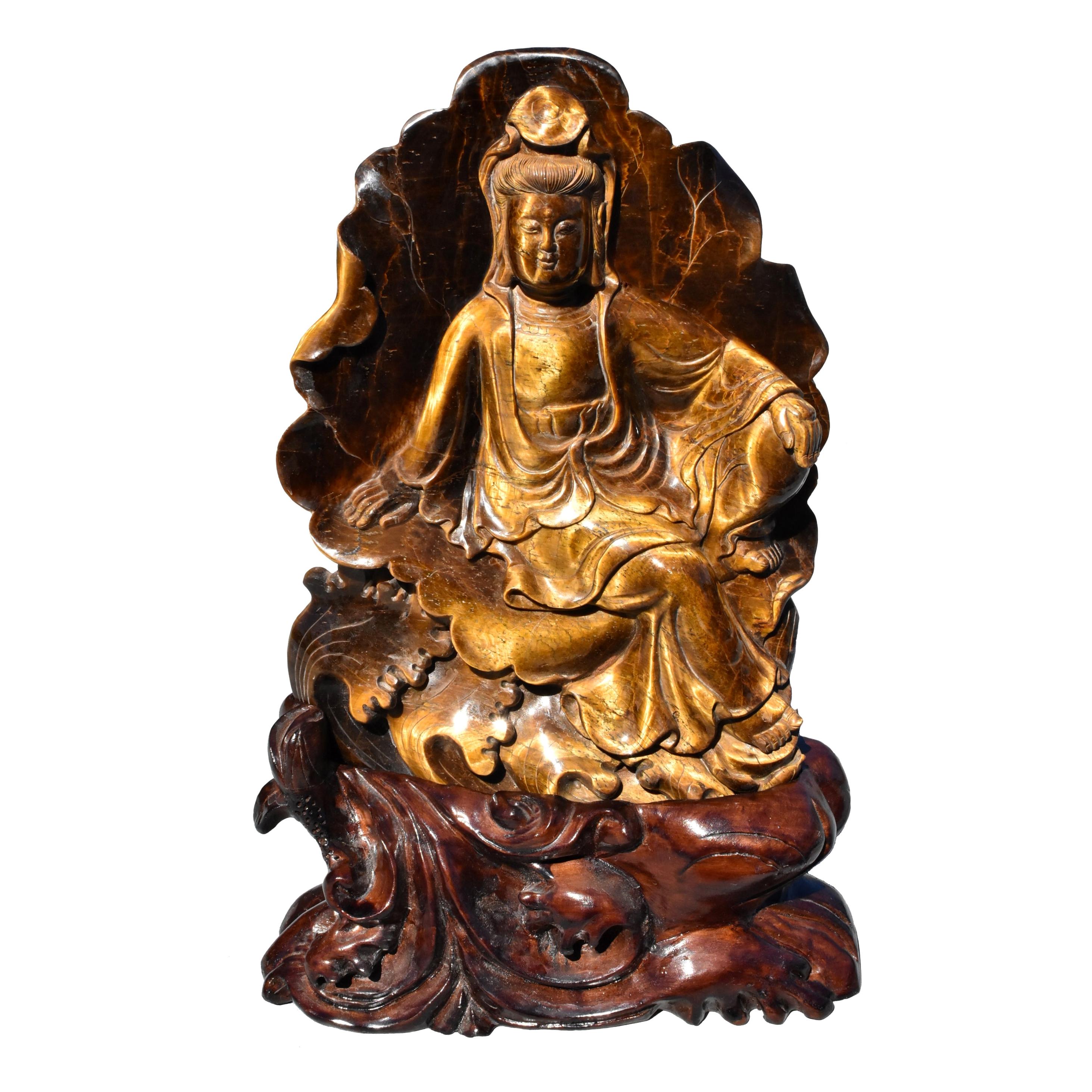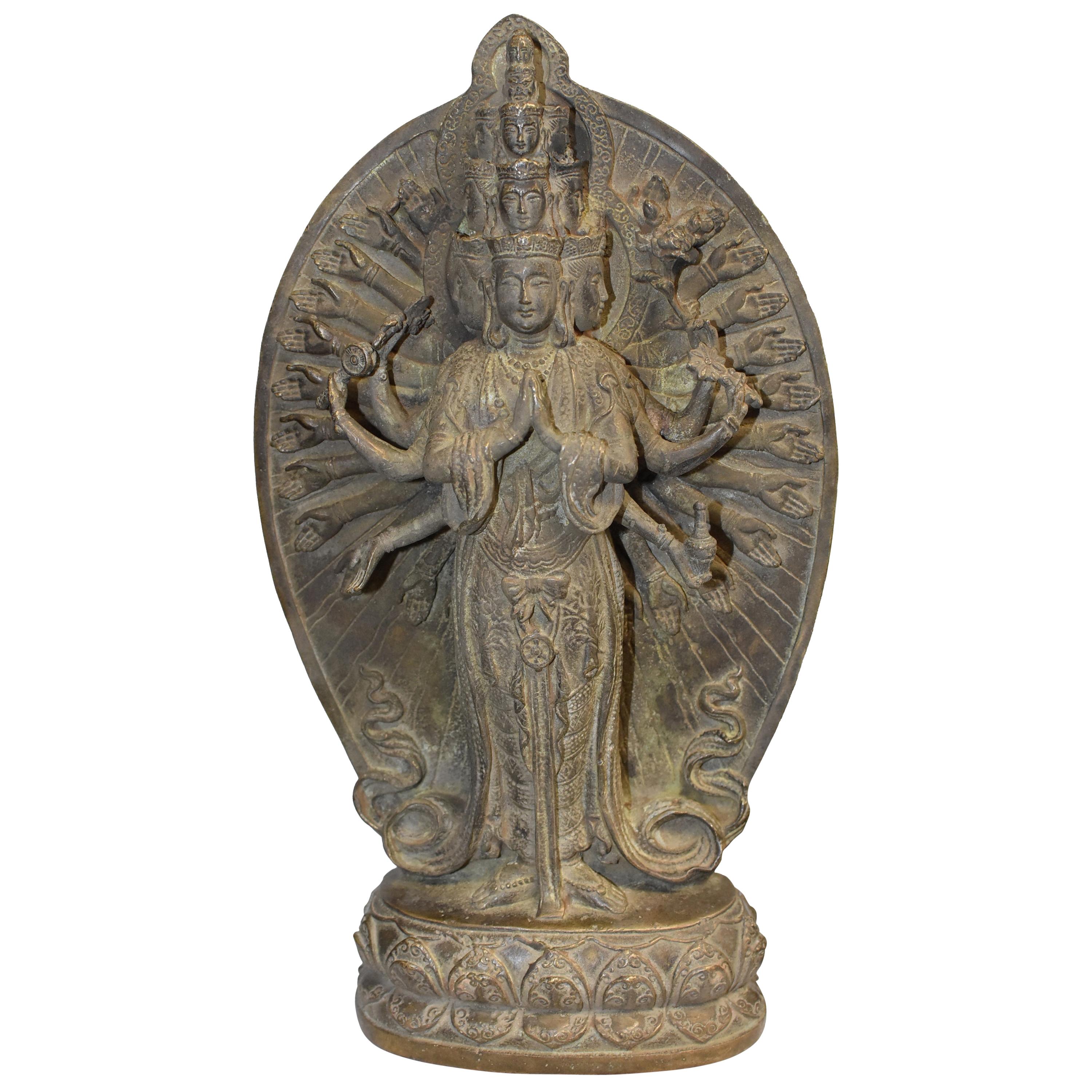Items Similar to Large Statue - Guan-yin In Jadeite Stone - China - Period: Art Nouveau
Want more images or videos?
Request additional images or videos from the seller
1 of 6
Large Statue - Guan-yin In Jadeite Stone - China - Period: Art Nouveau
About the Item
Very beautiful realization in Jadeite stone made in China.
This large statue represents "Guan-Yin" standing dressed in a magnificent long dress crowned with a tiara of pearls, as the ideal of beauty and femininity.
She holds in her hands a tray full of unopened lotus flowers, a symbol of purity.
First described in the year 1846, jadeite was so named by a French mineralogist named Augustin A. Damour.
The name jadeite comes from the term "piedra de ijada" which means "flank stone" because of its many virtues on the kidneys.
Jadeite is only found in certain parts of the globe including Japan, Mexico, the United States, China and Guatemala.
Unlike nephrite or other varieties of jade, jadeite is considered much rarer and more qualitative.
Period: End of the 19th century - Beginning of the 20th century - Art Nouveau
Dimensions: Height: 98cm x Width: 30cm x Depth: 18cm
Guan-Yin, also called the "Chinese virgin", embodies compassion. She is an important figure of Buddhism in China and her name can be translated as "she who hears the cries of the world" "Guan" means to contemplate and "Yin" means incantation.
Her cult was introduced in China in the 3rd century and gradually gained importance in the Tang dynasty and then in the Song dynasty.
The goddess Guan-Yin has become very popular among Chinese people, even among non-Buddhists.
It appears in many religious writings, in artistic works (paintings and sculptures) as well as in ancient literature.
- Dimensions:Height: 38.59 in (98 cm)Width: 11.82 in (30 cm)Depth: 7.09 in (18 cm)
- Style:Art Nouveau (Of the Period)
- Materials and Techniques:
- Place of Origin:
- Period:
- Date of Manufacture:XIX th
- Condition:
- Seller Location:CRÉTEIL, FR
- Reference Number:1stDibs: LU7814236341012
About the Seller
4.0
Vetted Seller
These experienced sellers undergo a comprehensive evaluation by our team of in-house experts.
1stDibs seller since 2022
9 sales on 1stDibs
Typical response time: Several days
- ShippingRetrieving quote...Ships From: CRÉTEIL, France
- Return PolicyA return for this item may be initiated within 14 days of delivery.
More From This SellerView All
- Large Laughing Buddha Statue - Green Hard Stone - China - Period: Art NouveauLocated in CRÉTEIL, FRVery nice realization in green hard stone made in China. This large statue depicts the standing "Laughing Buddha" wearing a necklace of pearls of wisdom in his left hand and a ball in his right hand known as the ball of wealth. A large solar disc, symbolizing light, illuminates the Buddha's smile. The meaning of the laughing Buddha with beads and/or a ball of wealth is that of meditation. The representation of the wealth ball is a sign of wealth and prosperity. Period: Late 19th century - Early 20th century - Art Nouveau Dimensions: Height: 103,5cm x Width: 30cm x Depth: 18cm The image of the Laughing Buddha is inspired by a wandering Chinese monk, Budai (Hotei, in Japanese), who lived there centuries ago and believed to be Maitreya, or the Buddha to come. The plump figure and the benevolent attitude of the statue suggest contentment, magnanimity and plenitude. Often referred to as the Laughing Buddha, his signature smile symbolizes contentment and pure joy. The Laughing Buddha is considered a symbol of good luck, and rubbing its big head or belly is believed to bring good fortune and wealth. The fat belly of the Laughing Buddha is a symbol of tolerance, it also shows that prosperity and wealth can go hand in hand with enlightened consciousness. If we talk about Hinduism, Lord Kuber is considered as the Lord of Wealth and Fortune. However, in China, people used to keep a Laughing Buddha statue...Category
Antique Late 19th Century Chinese Art Nouveau Figurative Sculptures
MaterialsStone
- Large Laughing Buddha Statue - Green Hard Stone - China - Period: Art NouveauLocated in CRÉTEIL, FRVery nice realization in green hard stone made in China. This large statue depicts the standing "Laughing Buddha" wearing a necklace of pearls of wisdom in his left hand and a ball in his right hand known as the ball of wealth. A large solar disc, symbolizing light, illuminates the Buddha's smile. The meaning of the laughing Buddha with beads and/or a ball of wealth is that of meditation. The representation of the wealth ball is a sign of wealth and prosperity. Period: Late 19th century - Early 20th century - Art Nouveau Dimensions: Height: 103,5cm x Width: 30cm x Depth: 18cm The image of the Laughing Buddha is inspired by a wandering Chinese monk, Budai (Hotei, in Japanese), who lived there centuries ago and believed to be Maitreya, or the Buddha to come. The plump figure and the benevolent attitude of the statue suggest contentment, magnanimity and plenitude. Often referred to as the Laughing Buddha, his signature smile symbolizes contentment and pure joy. The Laughing Buddha is considered a symbol of good luck, and rubbing its big head or belly is believed to bring good fortune and wealth. The fat belly of the Laughing Buddha is a symbol of tolerance, it also shows that prosperity and wealth can go hand in hand with enlightened consciousness. If we talk about Hinduism, Lord Kuber is considered as the Lord of Wealth and Fortune. However, in China, people used to keep a Laughing Buddha statue...Category
Antique 19th Century Chinese Chinoiserie Figurative Sculptures
MaterialsStone
- Bronze Proof - Standing Race Horse - John Willis Good - Period: Art NouveauBy John Willis GoodLocated in CRÉTEIL, FRA bronze proof with a black brown patina on a flowery terrace, magnified by a very nice griotte marble base "Standing Race Horse", also known as "Saddled Race Horse", following the e...Category
Antique Early 1900s Art Nouveau Animal Sculptures
MaterialsBronze
- Natural Stone Sculpture - Sodalite - China - Late 19th Century PeriodLocated in CRÉTEIL, FRA very fine piece of natural stone, Sodalite, made in China. Finely chiselled, this large statue depicts a scene of life in which several ancient symbols stand side by side, such as the Phoenix, swallows, a horse, earthly abundance with its luxuriant vegetation, fruit, but also food from the ocean and its generous fish, a man, a woman and a child. First discovered in Greenland in 1806, Sodalite was analysed by a Scottish chemist 5 years later (1811), Mr Thomas Thomson. Several long years went by without it achieving any real success. It was not until 1891 that the stone was recognised as an ornamental stone. It was during a diplomatic trip to Canada in 1901 that Mary de Teck (wife of King George V) discovered Sodalite and fell under the spell of this natural stone. The princess ordered a large quantity of Sodalite to decorate her London flats. Sodalite quickly became fashionable. Period: Late 19th century - Napoleon III Dimensions: Total height with base: 92cm x Width: 31.5cm x Depth: 27cm Dimensions of wooden base: Height: 7cm x Length: 25cm x Width: 23cm But what do these symbols mean? The phoenix, a mythological bird, symbolises purification and rebirth, as it is said to rise from its own ashes. This magnificent bird is also synonymous with good fortune, opportunity and luck in Asian cultures. In feng shui, the phoenix is also one of the four celestial animals (sometimes also known as the red bird or red raven). The red phoenix...Category
Antique 19th Century Chinese Other Abstract Sculptures
MaterialsStone
- Limoges Porcelain, Argan Statue, the Imaginary Invalid, Period: Early 20thLocated in CRÉTEIL, FRLovely and rare collector's statue, in Limoges porcelain, theatrical character representing "Argan" from Molière's famous comedy: "The Imaginary Invalid". Argan is the imaginary patient, what in scholarly language is called a hypochondrium. Apart from this defect, he is rather a good man and a good father. However, he is under the control of a second hypocritical woman whom he does not want to upset, as well as doctors who...Category
Early 20th Century French Figurative Sculptures
MaterialsCeramic
- Cavalier Terracotta Turquoise Glaze - Chinese Enamels - Period: 19th CenturyLocated in CRÉTEIL, FRA delightful statuette depicting a rider riding his mount, in terracotta with a turquoise, brown and white glaze known as three colours (sancai). The horse is standing on an oblong ...Category
Antique 19th Century Chinese Other Figurative Sculptures
MaterialsTerracotta
You May Also Like
- Tiger's Eye Water Moon Guan Yin Avalokiteshvara StatueLocated in Somis, CAA magnificent natural Tiger's Eye sculpture depicting the compassionate Bodhisattva Water Moon Guan Yin, Avalokiteshvara. Seated on a lotus base in rajalilasana, the ‘posture of royal ease...Category
2010s Chinese Sculptures and Carvings
MaterialsQuartz, Multi-gemstone
- Splendid Impressively Large Life Size Chinese Guan Yin Marble FigureLocated in Hopewell, NJAmazing life size beautiful white marble Guan Yin sculpture having meticulous detail and beautiful peaceful expression. Appropriate for display indoors or in the garden. In Chinese ...Category
Early 20th Century Chinese Chinese Export Figurative Sculptures
MaterialsMarble
- Tiger's Eye Water Moon Guan Yin Avalokiteshvara Buddha StatueLocated in Somis, CAA magnificent natural Tiger's Eye sculpture depicting the compassionate Bodhisattva Water Moon Guan Yin, Avalokiteshvara. Backed by a lotus leaf and on top of water wavers, Avalokiteshvara is shown seated in rajalilasana, the ‘posture of royal ease...Category
2010s Chinese Sculptures and Carvings
MaterialsQuartz, Multi-gemstone
- Bronze Multiple Armed Avalokitesvara Guan Yin Statue, Very FineLocated in Somis, CAA most exquisite bronze Multiple Headed and Armed Avalokitesvara Guan Yin statue. Standing on double lotus throne with the main pair of hands held in t...Category
20th Century Chinese Sculptures and Carvings
MaterialsBronze
- Gilt Bronze Tibetan Water Moon Guan Yin Avalokiteshvara StatueLocated in Somis, CAA magnificent gilt bronze statue of Tibetan Avalokiteshvara, the compassionate Bodhisattva Water Moon Guan Yin. Seated on a lotus base in rajalilasana, the "posture of royal ease...Category
20th Century Chinese Sculptures and Carvings
MaterialsBronze
- Natural Lapis Lazuli Statue of Guan Yin 6 lb Finest GradeLocated in Somis, CAA rare, hand carved, masterpiece natural fine grade lapis lazuli Kwan Yin sculpture. Kwan Yin has an oval-shaped face with arched eyebrows and downcast eyes casting a serene aura, framed by long-lobed ears and an ushnisha covered under a hood as part of her fluid robe. She holds a Ruyi scepter in her right hand. Her left had is shown in motion of flicking blessing water. A stylized panel of flame backs Kwan Yin, symbolizing her power and spiritual superiority. To her left is a full bloom of lotus, a symbol of peace and enlightenment. The sculpture is masterfully carved with her facial details beautifully depicted. A custom handmade root stand complements this extraordinary statue. The lapis statue...Category
2010s Afghan Figurative Sculptures
MaterialsLapis Lazuli
Recently Viewed
View AllMore Ways To Browse
Jadeite Statue
Goddess Of Compassion
Jade Tray
Japanese Antique Statue
Nephrite Statues
Kuba Drum
Black Bronze Sculpture
Napoleon Sculpture Marble
Roman Torso Sculpture
Bronze Nude Athlete Sculpture
Rare Devil
Statuary On Stand
Borneo Sculpture
Glossy Clothes
Figurine Jesus
Indo Greek
Vintage Puppet Show Theater
Diquis Necklace

